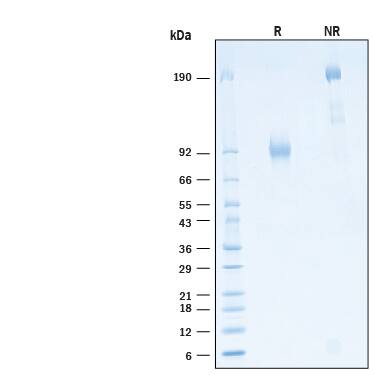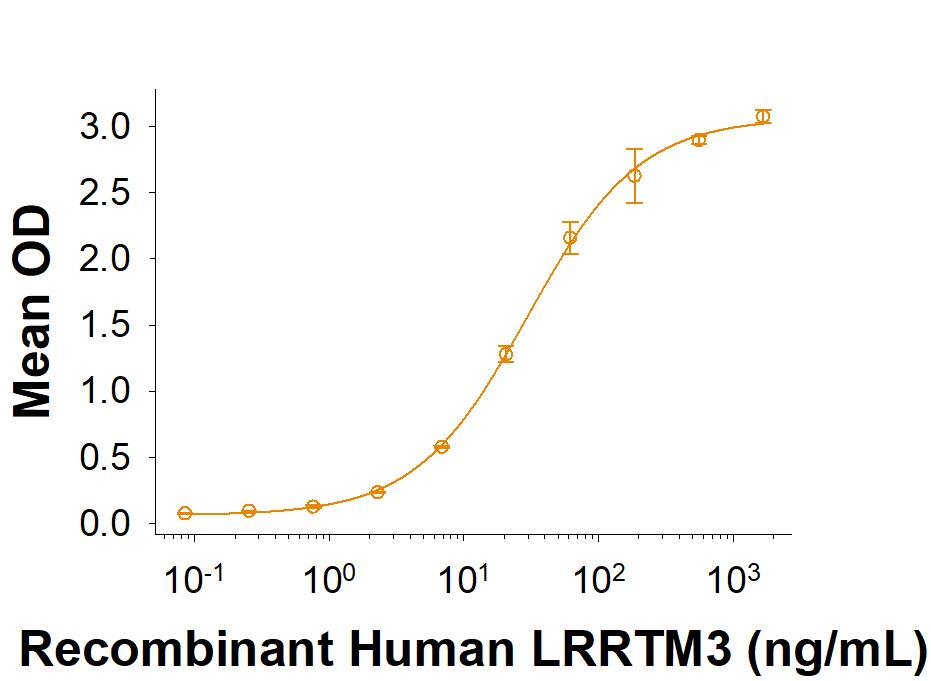Recombinant Human LRRTM3 Fc Chimera Protein, CF
R&D Systems, part of Bio-Techne | Catalog # 11357-LR

Key Product Details
Source
Accession #
Structure / Form
Conjugate
Applications
Product Specifications
Source
| Human LRRTM3 (Glu31-Lys419) Accession # Q86VH5.2 |
IEGRMD | Human IgG1 (Pro100-Lys330) |
| N-terminus | C-terminus |
Purity
Endotoxin Level
N-terminal Sequence Analysis
Predicted Molecular Mass
SDS-PAGE
Activity
When Recombinant Human APP/Protease Nexin II (Catalog # 3466-PI) is immobilized at 1 µg/mL (100 µL/well), Recombinant Human LRRTM3 Fc Chimera (Catalog # 11357-LR) binds with an ED50 of 8.00-96.0 ng/mL.
Scientific Data Images for Recombinant Human LRRTM3 Fc Chimera Protein, CF
Recombinant Human LRRTM3 Fc Chimera Protein Binding Activity.
When Recombinant Human APP/Protease Nexin II (3466-PI) is immobilized at 1 µg/mL (100 µL/well), Recombinant Human LRRTM3 Fc Chimera Protein (Catalog # 11357-LR) binds with an ED50 of 8.00-96.0 ng/mL.Recombinant Human LRRTM3 Fc Chimera Protein SDS-PAGE.
2 μg/lane of Recombinant Human LRRTM3 Fc Chimera Protein (Catalog # 11357-LR) was resolved with SDS-PAGE under reducing (R) and non-reducing (NR) conditions and visualized by Coomassie® Blue staining, showing bands at 76-93 kDa and 150-190 kDa, respectively.Formulation, Preparation and Storage
11357-LR
| Formulation | Lyophilized from a 0.2 μm filtered solution in PBS with Trehalose. |
| Reconstitution | Reconstitute at 250 μg/mL in PBS. |
| Shipping | The product is shipped at ambient temperature. Upon receipt, store it immediately at the temperature recommended below. |
| Stability & Storage | Use a manual defrost freezer and avoid repeated freeze-thaw cycles.
|
Background: LRRTM3
Human LRRTM3 (leucine-rich repeat transmembrane neuronal 3) is a 63 kDa (predicted) type I transmembrane protein, and one of four members of the LRRTM family of proteins within the leucine-rich repeat (LRR) superfamily (1). There are two isoforms of LRRTM3. Isoform 1 is synthesized as a precursor with a 30 amino acid (aa) signal sequence, a 389 aa extracellular region, a 21 aa transmembrane region, and a 141 aa cytoplasmic region. In isoform 2, aa 513 is changed from isoleucine to valine, and aa 514 to 581 are missing, producing a cytoplasmic region of only 74 aa. The extracellular region of both isoforms contains one N-linked glycosylation site, a leucine-rich repeat N-terminal domain bordered by four conserved cysteines, and 10 LRRs flanked by cysteine-rich domains (1). The cytoplasmic region of both isoforms contains several tyrosine, serine, and threonine residues that have the potential to be phosphorylated, and thus to be involved in signal transduction (1). The C-terminal of isoform 2 also contains a conserved glutamic acid-cysteine-glutamic acid-valine sequence for potential interaction with PDZ proteins (1 - 2). Mature human LRRTM3 (isoform 1) is 98% identical to mouse LRRTM3. In the mouse, beginning at 8.5 dpc, strong levels of LRRTM3 can be detected in the neural progenitors of the neural plate that will develop into the rostral neural tube, the forebrain, a stripe in the hindbrain, and the region of the presomitic mesoderm/somite boundary (2). By 15 dpc, LRRTM3 is expressed broadly and accumulates thereafter (3). In the adult, LRRTM3 is expressed almost exclusively in the brain with high expression in the cortical laminae and dentate gyrus, as well as detectable levels in the hypothalamus and amygdala (3). Functionally, LRRTM3 may be involved in the formation of the CNS and maintenance of CNS structure and function in the adult brain (1). In addition, LRRTM3 has been shown to promote processing of amyloid-precursor protein by BACE1, and is a positional candidate gene for late-onset Alzheimer’s disease (3).
References
- Lauren, J. et al. (2003) Genomics 81:411.
- Haines, B.P. and P.W.J. Rigby (2007) Gene Expr. Patterns 7:23.
- Majercak, J. et al. (2006) Proc. Natl. Acad. U.S.A. 103:17967.
Long Name
Alternate Names
Gene Symbol
UniProt
Additional LRRTM3 Products
Product Documents for Recombinant Human LRRTM3 Fc Chimera Protein, CF
Product Specific Notices for Recombinant Human LRRTM3 Fc Chimera Protein, CF
For research use only

